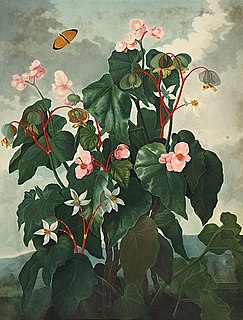
Begonia is a genus of perennial flowering plants in the family Begoniaceae. The genus contains more than 2,000 different plant species. The Begonias are native to moist subtropical and tropical climates. Some species are commonly grown indoors as ornamental houseplants in cooler climates. In cooler climates some species are cultivated outside in summertime for their bright colorful flowers, which have sepals but no petals.
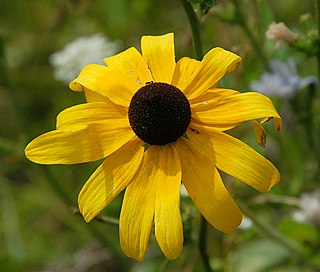
Rudbeckia hirta, commonly called black-eyed Susan, is a North American flowering plant in the family Asteraceae, native to Eastern and Central North America and naturalized in the Western part of the continent as well as in China. It has now been found in all 10 Canadian Provinces and all 48 of the states in the contiguous United States.

The cane begonias are a group of Begonia cultivars. Their name derives from their tough, bamboo-like stems. They can grow up to 10 ft (3.0 m) tall, which may necessitate staking. They are often ideal as houseplants when kept under control.
The Chinese Elm cultivar Ulmus parvifolia 'Hokkaido' is an older cultivar of Japanese origin.

Symphyotrichum novi-belgii, commonly called New York aster, is a species of flowering plant. It is the type species for Symphyotrichum, a genus in the family Asteraceae, whose species were once considered to be part of the genus Aster. Plants in both these genera are popularly known as Michaelmas daisy because they bloom around September 29, St. Michael’s Day.
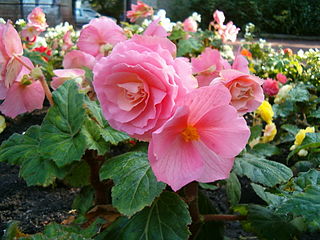
Tuberous begonias are a group of Begonia cultivars, sometimes regarded as some of the most spectacular of the genus.
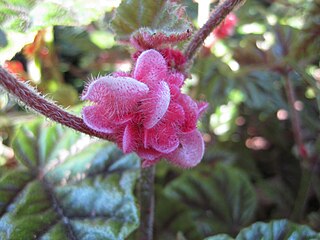
Begonia incarnata is a species of plant in the family Begoniaceae, native to Brazil. It is a shrublike evergreen perennial growing to 1 metre (39 in), bearing large, asymmetrical green leaves with a metallic sheen, and dark green veins. It produces small hairy pink flowers. As it does not tolerate temperatures below 10 °C (50 °F), in temperate regions it must be grown under glass.
The elm cultivar Ulmus 'Betulaefolia Nigrescens', the Black Birch-leaved Elm, reportedly a seedling of a purplish-leaved elm, was first described by Pynaert in 1879 as U. campestris betulaefolia nigrescens. An U. campestris betulaefolia nigrescensHort. was distributed by the Späth nursery, Berlin, in the 1890s and early 1900s.
Begonia tonkinensis is a plant species in the family Begoniaceae. The species is part of the section Diploclinium. It was described in 1919 by François Gagnepain.
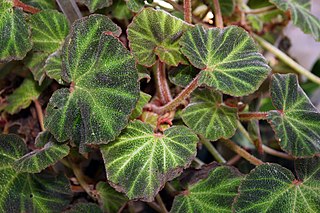
Begonia solimutata, the sun-changing begonia, is a species of flowering plant in the family Begoniaceae, native to Pará state in northern Brazil. It has gained the Royal Horticultural Society's Award of Garden Merit.

Begonia rex, the king begonia, is a species of flowering plant in the family Begoniaceae. It is found from Arunachal Pradesh to southeast China, and has been introduced to Bangladesh, Cuba, and Hispaniola. It is a parent to over 500 cultivars in the Begonia Rex Cultorum Group of houseplants. Other parents in the multitude of crosses made during the creation of the Group include Begonia annulata, B. cathayana, B. decora, B. diadema, B. dregei, B. grandis, B. hatacoa, B. palmata, and B. xanthina.

Begonia heracleifolia, the star begonia, is a species of flowering plant in the family Begoniaceae. It is native to Mexico and northern Central America, and has been introduced to Cuba, Hispaniola, Puerto Rico, and Trinidad and Tobago. A widespread species that is adapted to drought, it possesses considerable genetic and morphological variation, particularly in leaf shape and patterning.
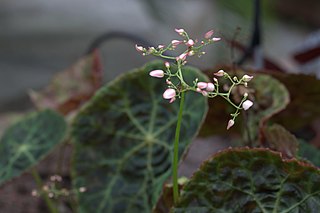
Begonia goegoensis, the fire-king begonia, is a species of flowering plant in the family Begoniaceae, native to Sumatra. In 1882 it was exhibited by Veitch and Sons and received a first class certificate from the Royal Horticultural Society. Valued for its striking red-backed leaves, it can be propagated from cuttings, although seeds may do better.
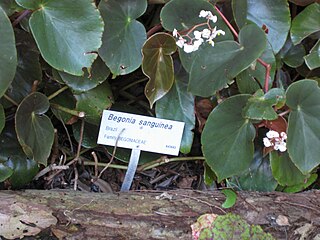
Begonia sanguinea, the beefsteak begonia or blood-red begonia, is a species of flowering plant in the family Begoniaceae, native to southern Brazil. Valued for the deep red color of the abaxial surface of their leaves, they are easy to propagate from cuttings.

Begonia sizemoreae is a species of flowering plant in the family Begoniaceae, native to Laos and Vietnam. It is popular in cultivation.
Begonia bogneri is a species of flowering plant in the family Begoniaceae, native to a single 1 ha locality on the Masoala Peninsula of Madagascar. Uniquely among begonias, it has linear, grass-like leaves. It does well in terrariums.
Begonia echinosepala is a species of flowering plant in the family Begoniaceae, native to southeastern Brazil. A bush reaching 6 ft (180 cm), it is infrequently offered in the nursery trade.

Begonia ulmifolia, the elm-leaf begonia, is a species of flowering plant in the family Begoniaceae. It is native to South America; Trinidad and Tobago, Venezuela, the Guianas, and eastern Brazil, and introduced to Mauritius, Réunion, and the Seychelles in the Indian Ocean. Cultivated for its ornamental foliage more than its flowers, it is suitable for green roofs in hot and humid areas.
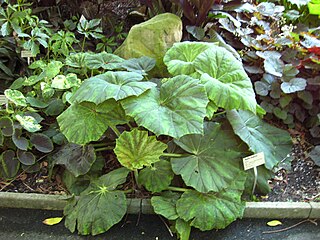
Begonia megaptera, the large winged begonia, is a species of flowering plant in the family Begoniaceae, native to Nepal, the eastern Himalaya, Assam, Bangladesh, and Myanmar. Very rare in its native habitat, it is cultivated as an ornamental and medicinal plant.

Begonia conchifolia, the zip begonia, is a species of flowering plant in the family Begoniaceae, native to Central America; El Salvador, Costa Rica and Panama. As a houseplant it does best out of direct sunlight. 'Red Ruby' is the best known cultivar.





















